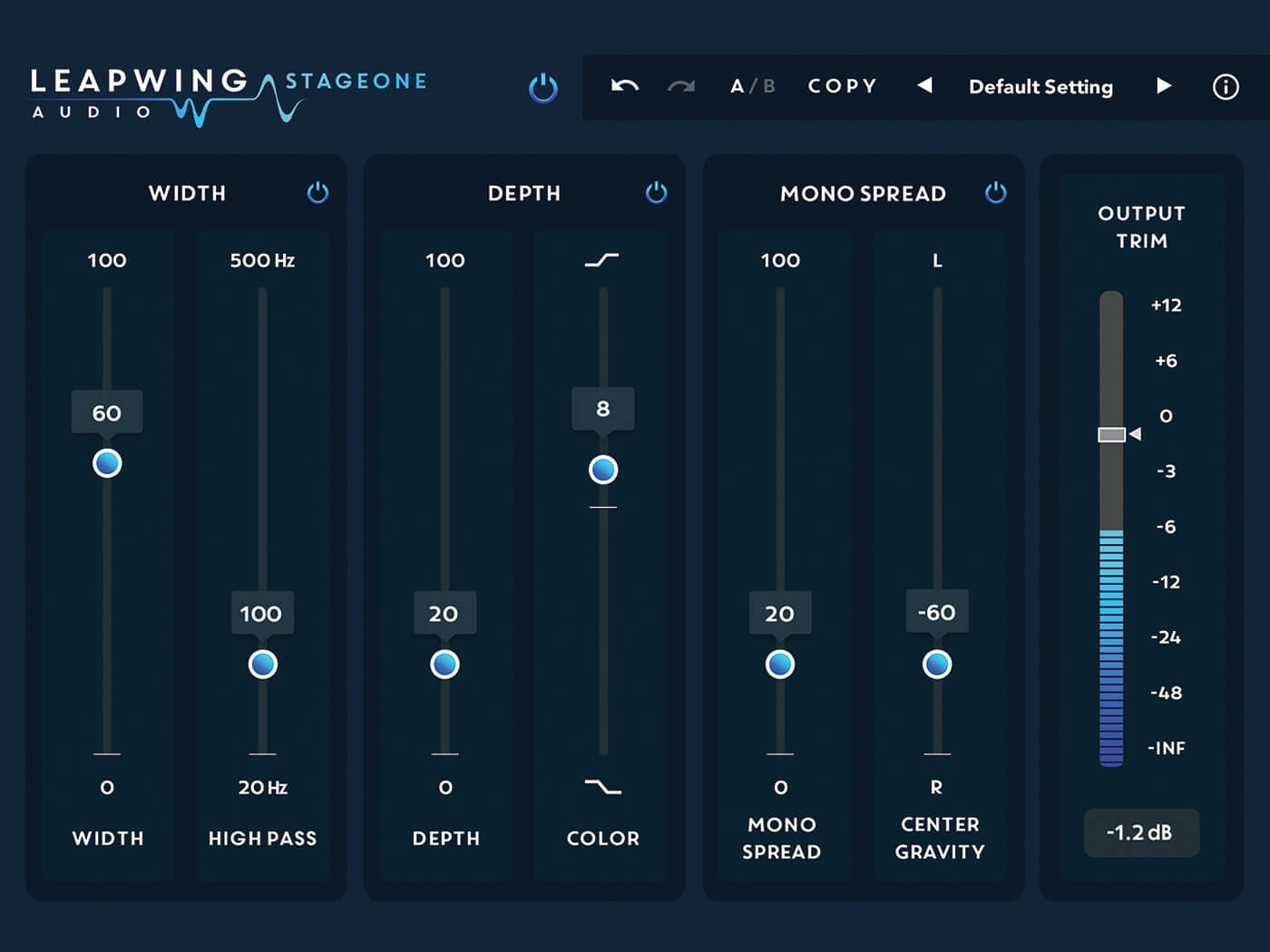Review: Leapwing Audio StageOne
Can Leapwing Audio’s third plug-in release make you a complete master of the stereo field? We take a leap off the stage to find out…


Price £179
Contact Leapwing Audio
Although the panning of a track is seen as an essential part of the mixing process, the actual width of a sound or channel is often overlooked, but can have a dramatic impact on the quality and depth of a mix. Leapwing Audio’s previous plug-in, CenterOne, focused on ways to control the centre channel, keeping the panorama intact, but this new release does the opposite. StageOne looks to modify the sides of the signal, adding depth and space to any recording, while maintaining mono compatibility.
Under the hood are three advanced and carefully tweaked algorithms for controlling width, which have been distilled down to two controls each, plus an Output Trim. First up is Width, which can be used on stereo signals to stretch the sides further away from the centre, while leaving the phantom centre signal untouched.
Slide it all the way up and it can even push the sound outside the speakers. Alongside this you have a high-pass filter, which is a nice addition. The Width effect is good for creating space as it increases the distance between the centre and side elements, and works well on things like backing vocals, or to gently widen a whole mix.
Next up is Depth, which adds subtle reflections to the signal, rather than the other algorithms, which simply manipulate what’s there. When you increase Depth, it adds a delicate, smearing ambience to the sound that pushes it back into the mix while adding a little extra width. This can act as a cleaner alternative to traditional reverbs to help push sounds back without making them muddy. Alongside this is a Color control, which acts as a tilt EQ to brighten or darken the reflections.
Phantom power
Finally, we have the Mono Spread control, which stretches the whole signal, including the phantom centre, allowing you to add natural sounding width to a mono source, or to thicken the middle of a mix. You can also weight the signal to the left or right with the Center Gravity control, which might be useful for re-balancing off-centre audio. Once you start experimenting with the sliders, it becomes clear that each of these carefully chosen effects has a role. The Width control will do nothing to a mono track, but if you add some Mono Spread, then it will widen it further.
Similarly, if you widen a track too far using Width, then you could use a little Mono Spread to help thicken the centre and fill the gap in the mix. We found the combination of all three controls worked wonders for pushing particular elements to the background and out of the way of foreground instruments, and it added a lovely, natural 3D feel to mono lead vocals.
Compared to other stereo widening plug-ins, StageOne is the smoothest and most transparent sounding, while retaining the centre punch and transient clarity. However, it’s not cheap and it uses a fair bit of CPU with all modules running. Also, the GUI is crisp, but a little uninspiring, and would benefit from better visual feedback. If you’re on a budget, there are other widening options available, but it you want the best possible quality, then this is an excellent, easy-to-use tool.
Key Features
- Minimum system requirements: VST, VST3, AU, AAX, Mac OS 10.10, Windows 8
- Three high-quality processing algorithms
- Widen the stereo image without affecting the centre
- Add subtle ambient depth and push sounds back
- Widen mono signals and phantom centre
- Mono compatible
- Clear, retina GUI
- Smooth, transparent sound
- Undo/redo and A/B comparison
Alternatives
UAD
Precision K-Stereo Ambience Recovery £149
Created for UAD in conjunction with mastering engineer Bob Katz, this extracts ambience from source material and adds natural depth and width to narrow sounding mixes.
Nugen Audio
Stereoizer $119
This allows you to expand a stereo image or create stereo from a mono signal, while retaining mono compatibility and avoiding unwanted artefacts. There’s visual feedback of the panorama and three algorithms to choose from.